Avengers: Endgame
“Six Stones. Three Teams. One shot.”
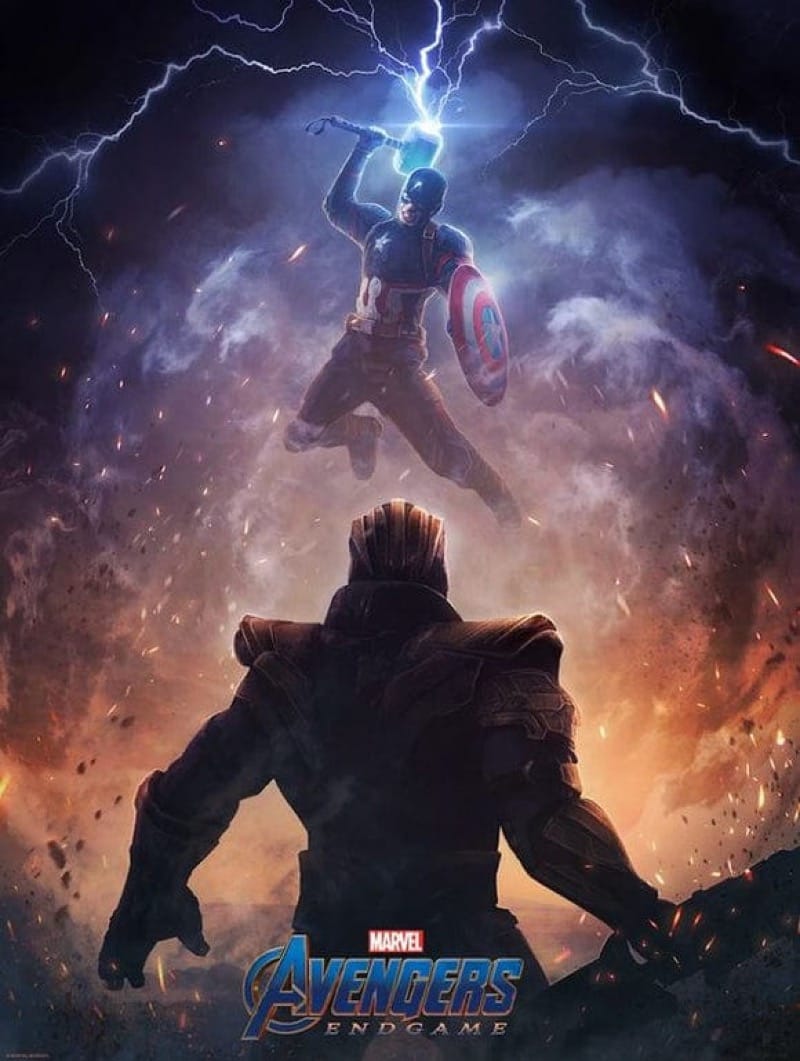
After their defeat at the hands of Thanos, when the Mad Titan used the incredible power of the Infinity Gauntlet to wipe out half of all sentient life in the galaxy, the remaining heroes… Thor, Black Widow, War Machine, Captain America, Iron Man, The Hulk, Rocket Raccoon, Hawkeye, Nebula, Ant-man, and Captain Marvel, must overcome impossible odds if they want to regain everything that they’ve lost.
Each summer, when I would visit my Dad as a kid, one of my favorite things to do when I was there was to go through my Uncle’s box of comics in my Grandparents’ basement. This box was the ur-source of my love of comics. It was from this box that I was first introduced to comics at a young age, as my grandparents would always grab a couple of random issues from it for me every time they’d visit.
Eventually, the box migrated from my Grandparents’ house to my Dad’s house, and each summer I’d take them all out, organize them by title, then put each title into numerical order, and then I’d stack them all in alphabetical order—why, yes, I am a little bit obsessive-compulsive, why do ask—and once all that good work was done… I would settle in and read them all In order.
And here I am now…
That box was an eclectic collection of old Silver Age books, which meant that they were predominantly DC and Marvel titles from the 60s and the 70s.

There were old Spider-mans, like the issue where Peter Parker killed the Green Goblin after the villain threw Gwen Stacy to her death from the top of the Brooklyn Bridge. There was the one where the X-Men fought Frankenstein’s Monster. There were a bunch of Iron Man, a ton of Captain America and the Falcon issues, as well as old Avengers, and Defenders, not to mention Avengers vs Defenders, and Marvel Triple Actions too. There was even a Silver Surfer #1, all beat up and read to tatters, but still pretty cool.
Also, quick tangent, looking back, I think the general lack of Fantastic Four issues in this box are probably why I usually don’t read that title to this day.
There were a ton of WW2 era books too, like Jeb Stuart and the Haunted Tank, Nick Fury and the Howling Commandos, Sgt. Rock, the Unknown Soldier, The Losers, and the Enemy Ace. There were a bunch of Batman books, of course, like when he had to wear rainbow-themed costumes, or when he became a giant, or the many times he accidentally murdered Robin, and the regular occurrence where he had to fight someone in a circus-themed death trap. There were some Flash books, a few Hawkmans too, a couple of Teen Titanss, and a bunch of Green Arrow and Green Lantern team-ups, which is where Oliver Queen was always ready to speak some truth to power… at least, y’know… in comic-book-type situations.
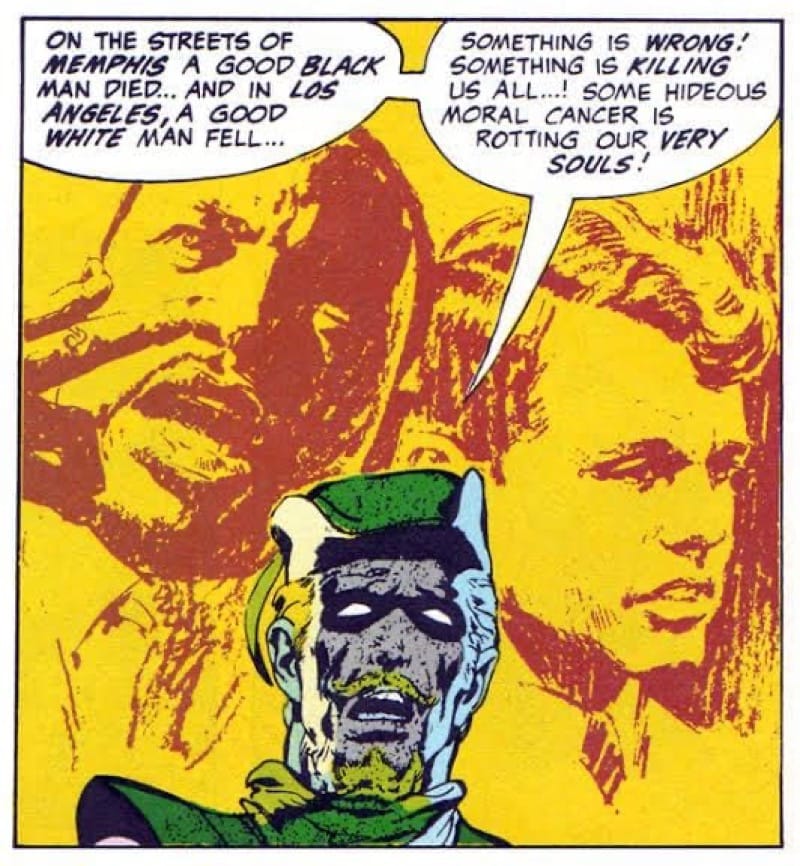
There were also a lot of those weird old Pre-Crisis Superman adventures, which are all amazing and ridiculous and completely out of left field. These were the kind of stories where Red Kryptonite might give Superman an ant head, or a lion head, or we‘d see a future where he becomes “Wheel-Chair” Superman, or maybe the King of Earth, or maybe he just had to eat a shitload of hamburgers or starve to death.
There were also ones where Superman’s best pal, Jimmy Olsen, would become his worst enemy in some way. There were a lot of those, honestly. Because of that, I’ve always felt like no one really hates Superman like his “best pal“ secretly does. But there were also the ones where Jimmy might become Superman’s barber, because he was somehow able to cut Superman’s indestructible hair. In other ones, Jimmy might become a superhero himself, like Elastic Lad, or Turtle Boy, or perhaps The Human Octopus, or maybe it would be the story where Superman somehow became Jimmy’s mean adoptive dad.
Then there were the comics about Superman’s girlfriend, Lois Lane. Here, she might be being blackmailed by Superman, or maybe she was being sent to jail for life for one shocking reason or another (usually murder). Other times, she might be having an affair with Batman maybe, or she was trying to trick Superman into admitting that he was actually Clark Kent, or she was trying to murder Superman’s old girlfriend, Lana Lang, in a fit of jealousy, or maybe she was just refusing to remove a giant lead box mask because she didn’t want Superman to see her face. And of course, there was the time where she turned Superman into a baby, and then she forced the super infant to help her rob banks.
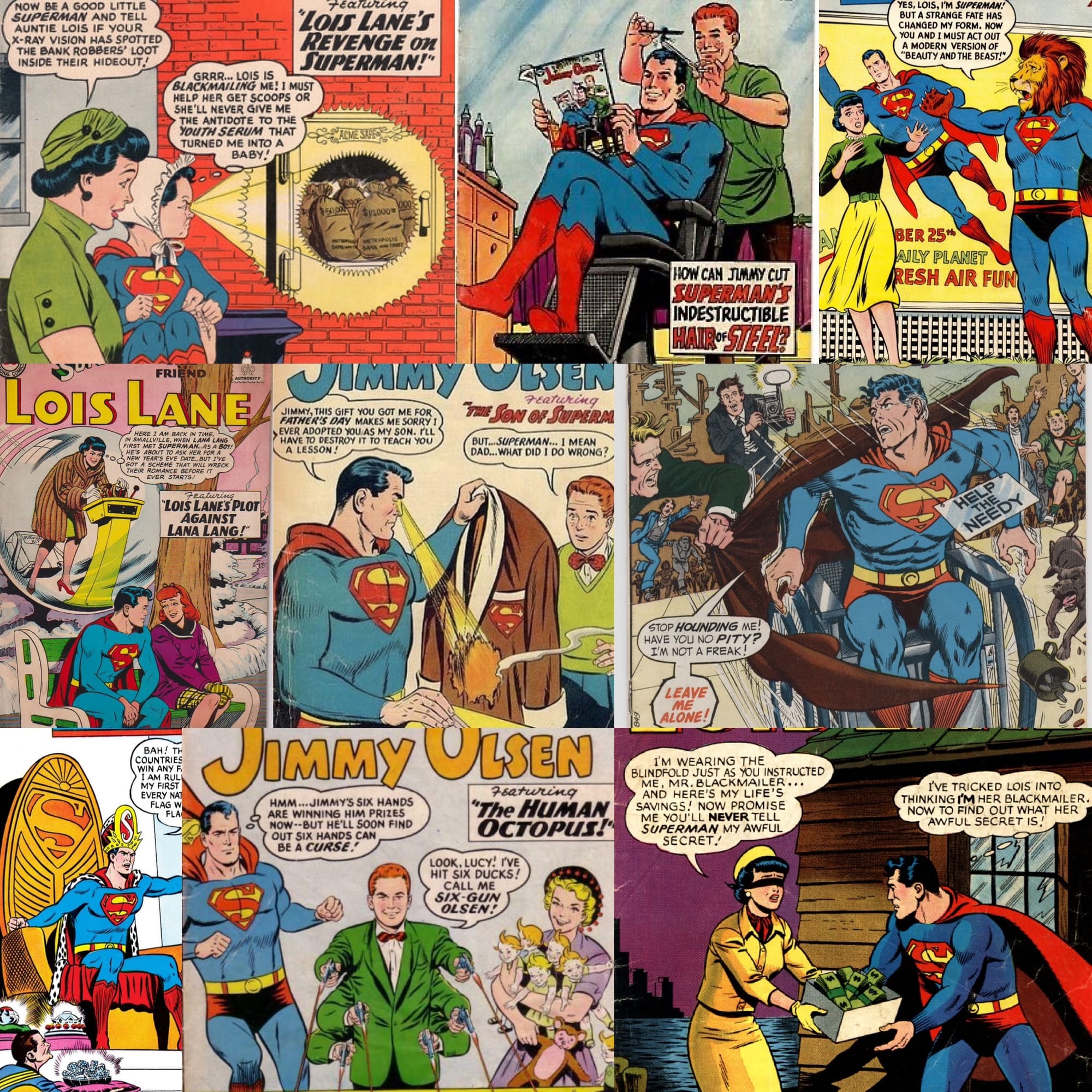
These particular stories don’t “count” anymore, of course. They are no longer considered to be canon. That was basically the whole point of the original Crisis on Infinite Earths crossover that I talked about in my Infinity War review. Much like in 1546, when the Council of Trent decided which books would officially be in the Bible, and which ones were no longer from God, I guess, The Crisis on Infinite Earths was all about deciding the “official” story of the DC Comics universe. That meant, much like the Bible, that tons of stories about those same characters was wiped out, shoved aside, and put away, and as a result, the “official” story is now packed with weird inconsistencies and narrative gaps.
Because, in a nutshell, when a story is no longer considered to be canon, this means that these stories are no longer considered to have actually happened to the characters. Much like the Books of the Bible that the Vatican keeps under lock and key in their deep vaults, these stories are now considered to be fluff, fun little bits of ephemera, little flights of fancy, and products of their time, so don’t look at them, don’t think about them, don’t consider them, and certainly don’t ask about them or cite them, just move along or we’ll burn you at the stake.
Of course, it’s fair to ask if any of these stories were ever considered to be “real“ when they were written, if any of it was, or if they were just meant to be parables that reflected the social mores of the time. It’s fair to ask if there was any thought at all toward constructing a cohesive narrative, or if… again, much like the Bible… all that shit was crafted by the Powers That Be that came later, in order to serve their own agenda, because it sure seems like, back then, when these stories were written, they just did whatever the fuck they wanted to.
But anyway…
Within that box, there were a bunch of Justice League of America books too—they’re basically The Superfriends—and it was here that I found what is still one of my favorite comic book crossovers ever.
Now, part of the reason why this particular story is one of favorites, and still thought of so fondly, is because it was one of the few stories in my Uncle’s box that had all of the issues in that specific story arc. Because of this, I was able to read the whole story, start to finish, instead of me eventually just running into a decade-old cliffhanger that would simply never be resolved. This was a time when Comic Book shops just didn’t exist for the most part, and even if I got lucky, and one did, and it was in the same city as me, one of the few traits my then-divorced parents seemed to share was a weirdly adamant refusal to drive me 20 minutes to my childhood Shangri La, so to be able to get all the issues in the story… that was special.
But mostly, this is one of my favorite stories because it was about two big super-teams being forced by circumstances to come together to save a third super-team that had been lost in time, and I love that kind of shit.
It’s just fun.
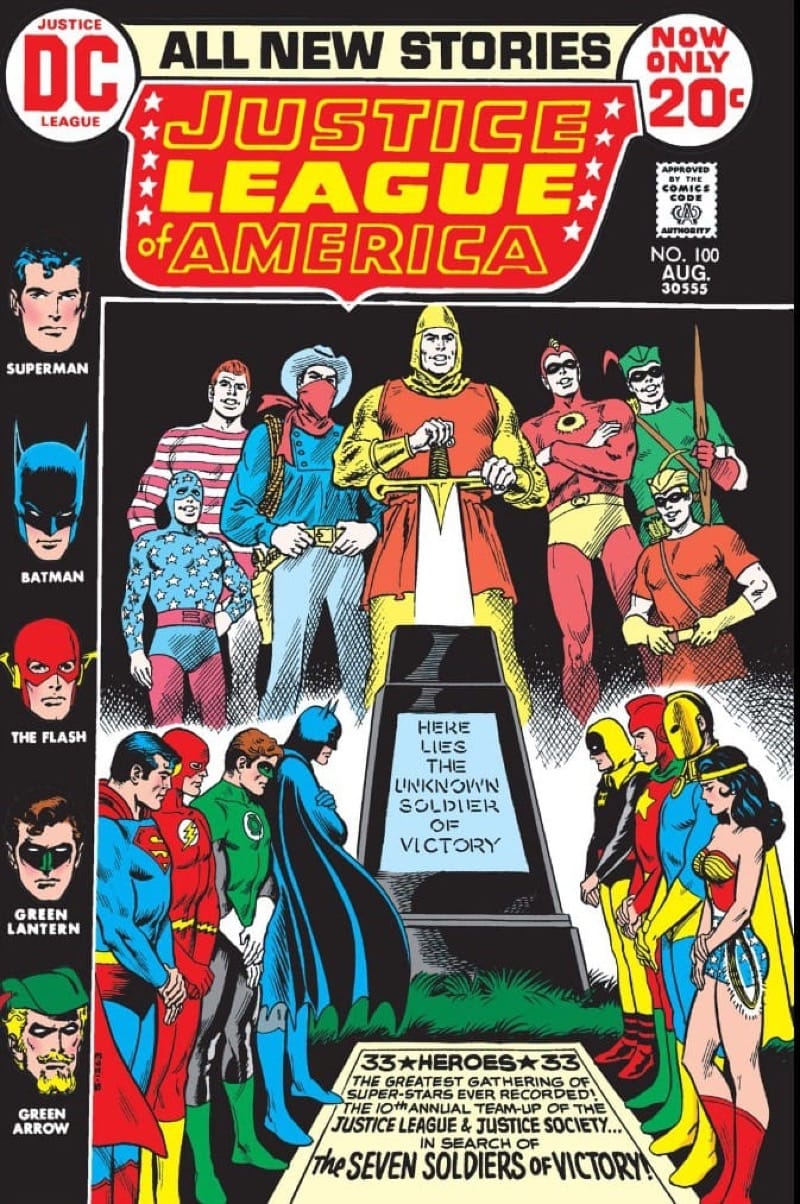
Of these three teams, one was made up of the familiar faces of the Justice League of America, Superman, Batman, The Flash, etc. The second super team was made up of their progenitors. Known as the Justice Society of America, these were all WW2 era heroes, from what is known as the Golden Age of comics, heroes like The Hourman, Starman, Doctor Mid-nite...
For the purposes of this story though, instead of being grandpa versions of superheroes, it was set in an early version of the multiverse, so the Justice League was from Earth 1, and the Justice Society was from Earth 2—Earth 3 was the world where all the evil versions of the heroes lives, btw—a classic DC Comics thing. One thing I always noticed as a kid, none of the various Earths ever seem to object to this numbering system. You’d think that everyone would be like: “uh… excuse me, what do you mean, you are from Earth 1 and we’re from Earth 2? We’re obviously from Earth 1, you are the ones from Earth 2.”
I guess that’s what makes them heroes.
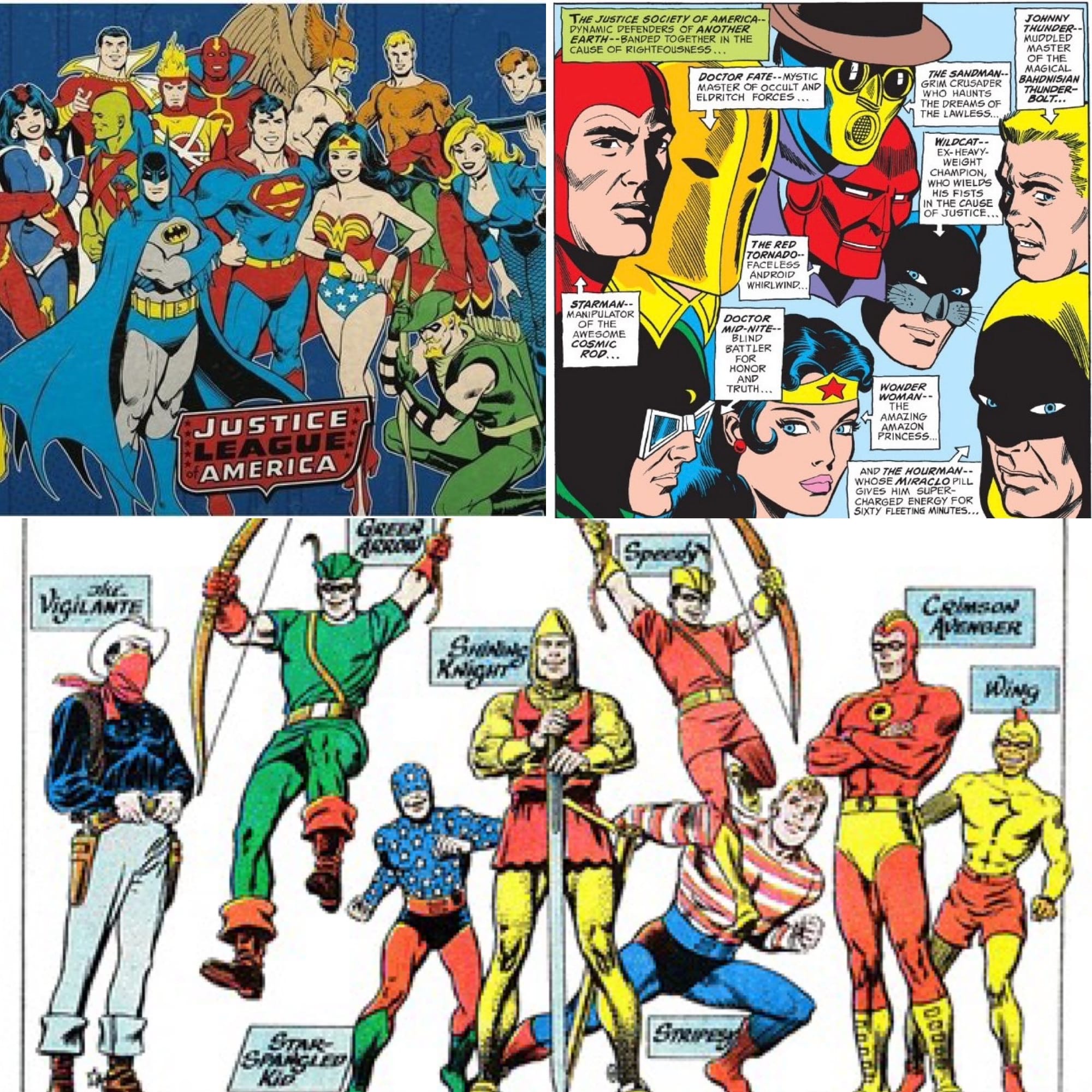
The story starts as these two teams suddenly find themselves faced with a threat that is beyond the ken of even the awesome might of their combined powers (it was a huge disembodied hand that was holding each Earth in a death grip, which is a thing that can happen in comic book universes).
Soon enough, the heroes realize that the key to defeating these… giant disembodied hands… is a secret known by only one group, the super team known as the Seven Soldiers of Victory that died fighting this same threat years ago.
But it turns out, the Seven Soldiers didn’t die, just that the energy backlash that resulted from them defeating these… giant disembodied hands… scattered them across time, and they’ve been lost ever since.
This means that, if they hope to stop these… giant disembodied hands… the two groups of superheroes must mix their forces, and then split up and travel through time in order to rescue the long-lost members of the Seven Soldiers of Victory, and return them to the present.

I don’t know if I’d say that this story was where my love of time travel stories actually started, as it was probably more the result of the TV show Voyagers, but it definitely planted some seeds. You’ll excuse the tangent, but… as an 8 year old fan of Voyagers, if I could’ve dressed like Phineas Bogg every single day, I totally would have, and if I’m ever able to retire as an old man, I will.
But I have wandered a bit far afield, so I digress…
By the time Endgame rolled around in 2019, especially after the wild adventure and the shocking downer of a cliffhanger that was Infinity War, the success of the MCU was undeniable, unprecedented even. Absolutely everyone considered the mega-franchise to be hot shit. Of course, the specific meaning of that term varied depending on who you asked, but regardless, people were talking, and according to Marketing folks, that’s a good thing. Endgame was the big cap, the big crescendo, the ending of the Infinity Saga, the big climax of what the last eleven years and 21 films of the MCU was all about…
And they fucking nailed it.
The butthurt weirdos out there love to talk incessantly about the “Death of the MCU,” because they hate it when something is being enjoyed by others instead of totally serving their own interests, so more than anything, they want it to end, and that’s why they won’t stop talking about it. But is the “Death of the MCU” actually a real thing? Is the fad of comic book movies totally dominating Box Offices finally peaking? Is this trend finally at an end, or is it at least finally ceding the main stage to some other trend?
If you ask me, that question is still up in the air.
First off, the answer has to be… not really, not if you look at the yearly box office results of the past few years, the Top Ten of each year being dominated by comic book films or films that might not technically be a comic book film, but it’s still a comic book film.
BUT…
If it is the end of the domination of Superhero films—and I’ll concede that it‘s possible that it might be, or at least, starting to be—nearly 2 decades at the top is a hell of a run. Besides, anyone who knows movies, and is being honest, will tell you, much like Musicals and Westerns and One-Man Army Action movies, it’s not like Hollywood will ever truly stop making Comic Book Films now, they’ll just make fewer of them.
But all that aside…
My point in bringing this up is that I think, if anything will ever be able to be said to be the thing that led to the death of the MCU, then it would be the fact that the Infinity Saga stuck the landing so perfectly with the two-punch combo of Infinity War and Endgame.
Because traditionally, one of the roughest parts about reading comic books is that there is no such thing as a permanent ending, only a stories’ temporary resolution. So as a result, it can be hard to pick up the next issue of comic book, especially the issue right after a huge story line that you have been following for a couple of years has finished up, and now a new story line has started, with a new creative team at the helm. Why would this be any different for a movie crowd? Honestly, it should be harder for them to just… go on to the next chapter. Comic book audiences are weirdly dedicated and loyal crowd, and they are used to this situation because it’s a regular thing, a huge story ends, and a month later, a new one starts.
Movie crowds, meanwhile, are generally much more fickle, much more impatient, and just as easily bored as they are easily distracted by a new set of shiny, jangling keys. It’s hard enough keeping a movie crowd’s interest in normal times, let alone in the wake of the completely satisfying climax and denouement of a decade-long, very popular story.
And in their defense, nothing is better than a good ending.
Maybe that’s why actual long-time fans of superhero comics are still enjoying the MCU, and looking forward to James Gunn’s new WB/DC film slate, because as I said, for the most part, comic books never really end, there’s new issues every month. And when comic books do end, it’s rare that they end well, or for very long.
Although, there have been a few…
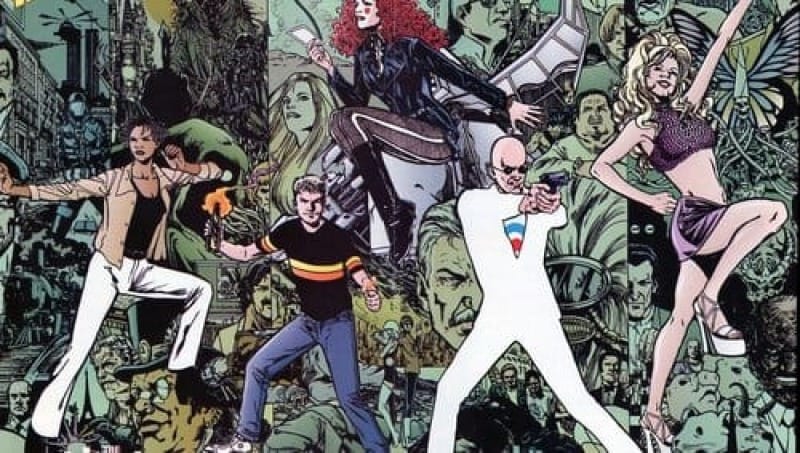
The Invisibles is about a group of magical anarchist terrorists who stand against a Lovecraftian organization called The Outer Church, a group whose entire existence is bent toward the control of humanity. It was a very hip, British sci-fi-influenced, New Age/London Underground/Punk Rock-flavored book about a Time Traveler, an Assassin, a Transgender Hereditary Shaman, the new Buddha—a delinquent from the East End—and a slew of others, revolutionaries in a story incorporating every grocery store tabloid conspiracy theory, in a time before conspiracy theories were mostly the home of racists and Christian fascists.
The story’s ending takes place on December 21st, 2012, which for years was the potentially apocalyptic event known as The End of the Mayan Calendar. It was notably an apocalyptic event that, much like the Death card in Tarot, was thought of not as an Ending, but as a New Beginning. So, when the Outer Church makes their final attack, the Invisibles outsmart them, and the world ends, but in the best way, leaving behind hate and embracing love.
It's good and satisfying, and also pretty weird.

Secret Wars, the version that was published in 2015, is a crossover that centers on the end of the Marvel Comics Multiverse—basically all of reality—and the remnant that briefly existed in the time before the new Multiverse was finally born. It’s also about the evolution of Doctor Doom as a character. He is the number one bad guy in Marvel comics—as well as the Final Boss of the next phase of the MCU—a metal-clad monster, Doom is a very powerful sorcerer, a technological genius, and the brutal despot of the country Latveria.
The God Emperor Doom, using magic and stolen cosmic power, having saved remnants of multiverse as all of reality collapsed, created a patchwork quilt of a world that he ruled. But then a couple of groups that also survived the collapse show up, see how wrong everything is, and a big fight results. But in the end, like always, it comes down to two dudes rolling around in the dirt, and this time, it’s former college roommates and longtime frenemies Reed Richards of the Fantastic Four and Dr. Doom, and… Doom realizes that he was wrong. So he surrenders his power to Reed, who recreates the multi-verse. It was a clean slate for a long-time era of comics, and a new era and a new evolution for an old character, and it was fantastically done.
It wasn’t permanent, of course, Doom is currently back to being a bad guy in the comic books, and has taken over the world… but that’s how shit goes in comics.
Still, for a while, it was pretty satisfying.
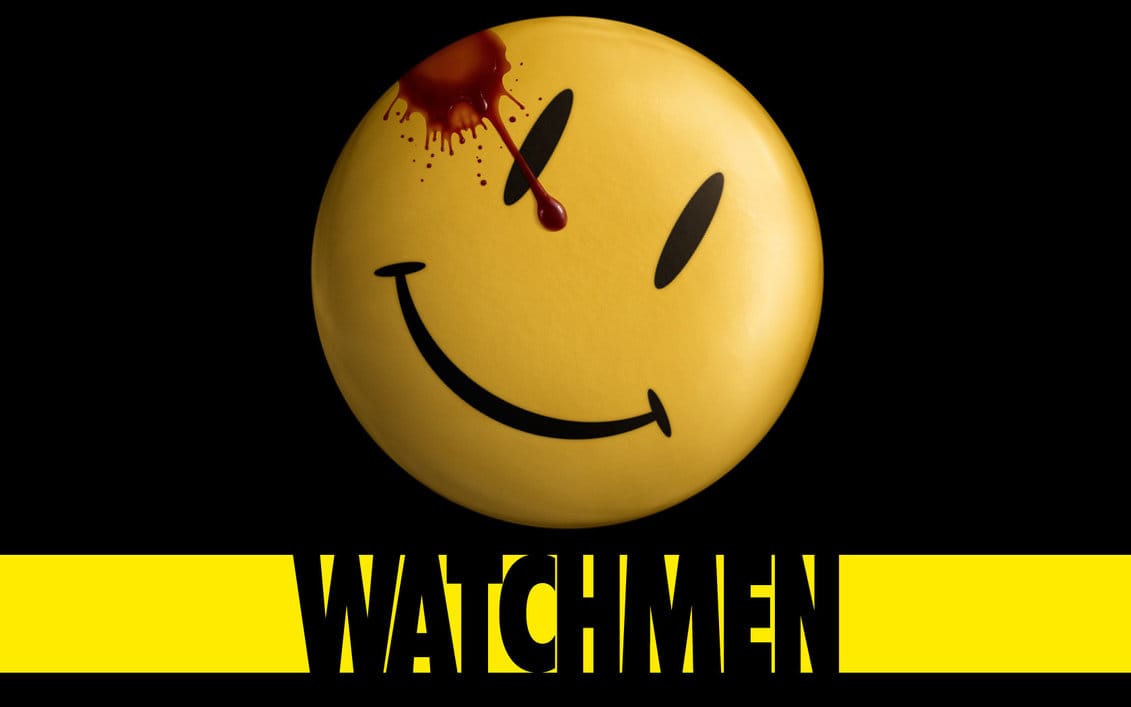
Based loosely on the Charlton Comics characters, Watchmen is the story of a world where, after a brief fad of masked heroes, they are now outlawed. Also, there is only one man with superpowers, a man called Doctor Manhattan, he is basically a God, and he is also an American. So, it’s a twisted mirror of a ugly and dystopian Cold War 1980s world, with a story that begins with a man who once wore a mask getting murdered, which then leads straight into the jaws of the apocalypse.
A lot of people talk about the main ending, the moment where the villain, a man called Ozymandius, who boasts himself as being the smartest man alive, finishes his big villain monologue by informing the heroes that they’re thirty-five minutes late in stopping him from launching his big plan. And to make it even worse, the big plan works, bringing about world peace. As a result, even though the plan only worked because of a bunch of lies and murder, the heroes have no choice but to keep it all secret. If they don’t, more people will die, billions more.
Which is a fantastic ending…
But for me, the best part of the story is the very last bit, which shows how Rorschach‘s journal reveals everything, and before the heroes set off to try to stop Ozymandius, he drops it in the mail for a local paper. It’s a crank paper, sure, but still, that ambiguous ending, the question of whether or not all the lies will be revealed, whether or not everything will be undone, is really great.
I really like how this adds meaning to Doctor Manhattan’s last words in the book as well, not just for the story, but as a commentary on comic books themselves, when he says: "Nothing ever ends."

I've talked about the Ultimate Universe before. This was an alternate universe that was basically a “New Reader” initiative. It was a relaunch of the classic Marvel Universe, but updated for the aughts, minus all the old baggage. It was another clean slate, and The Ultimate Spider-man comic was consistently one of the best monthly superhero books published for its decade-plus run.
Ultimate Spider-man was basically the classic story of Spider-man’s great power and great responsibility, but it had a ending, and that end took place during the final showdown between Spider-Man and the Green Goblin. Wounded, exhausted, and outnumbered, Spidey manages to defeat the Goblin, but he is fatally injured in the process. Still, Peter dies content, knowing that he was able to save MJ and his Aunt May, a redemption for not being able to save his beloved Uncle Ben.
On top of that, his death inspired Miles Morales to become the new Spider-man, who learned upon Peter’s death that with great power… comes great responsibility.

Simply put, the Dark Knight Returns is the Batman story. It is as annoyingly and tediously omnipresent in every single facet of the Batman mythos now, as it is an exceptionally well done and incredibly entertaining story.
The Dark Knight famously tells the story of an aging Batman, with nothing to lose and ready to leave it all on the field, who comes out of retirement in a dystopian Cold War world where all the superheroes are now gone. Unwilling to accept the world as it is, Batman burns through the local gangs, the local cops, his greatest villains, and finally even, his once friend, turned secret weapon of Reagan administration, Superman.
With the entire world against him, Batman gloriously fakes his own death for all the world to see, and while showing Clark once and for all who’s boos. Finally free, Bruce Wayne resolves to continue his war on crime from the shadows, this time with the small army of teenage zealots that has joined him. Throughout the book, Batman had continually assured himself “This would be a good death,” and finally at the end, as he goes over his plans in the deepest recesses of the Batcave, Bruce thinks, “This will be a good life. Good enough."
That’s so nice.
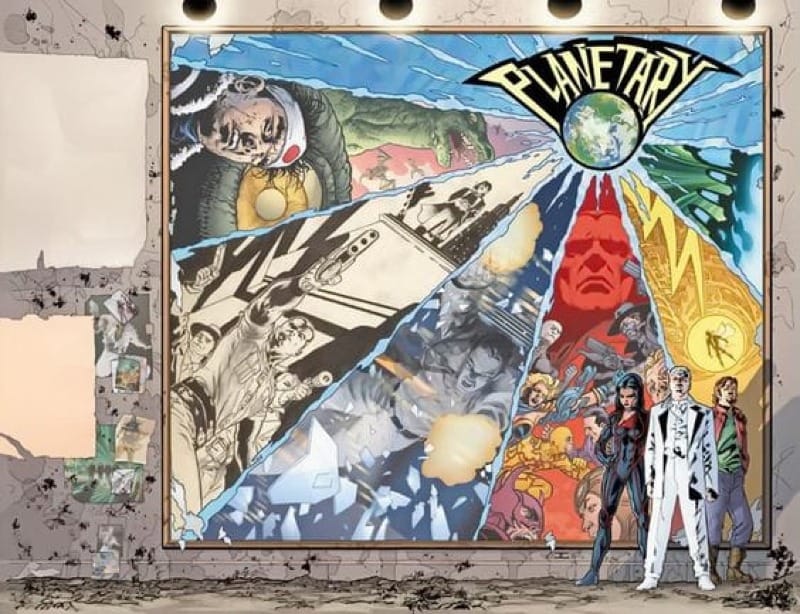
Planetary is one of my favorites comic books. Part of the reason why, is because of how it ends so perfectly, as a story that is both a metaphorical tour of the history of genre stories in pop culture, as well as the story of a team of super powered individuals exploring of the secret history of the world.
After the big ending, the series’ denouement shows our heroes in the Planetary organization aboard an multiverse-sailing Shiftship, as they leave their universe to find out what else may be out there. Besides the whole “the adventure continue…” classic ending, this is also the comic book urging readers to be like the team, to leave this world behind, and to go find new wonders to explore, with the implication being that they should create those worlds themselves.
Love that.
So, at this point, it’s probably fair for me to admit that pretty much all of these great endings I have listed are not actually endings at all, but are more like… good lulls before the next chapter. I don’t mind that. Like I said, that’s just how things work in comics.
Nothing ever ends.
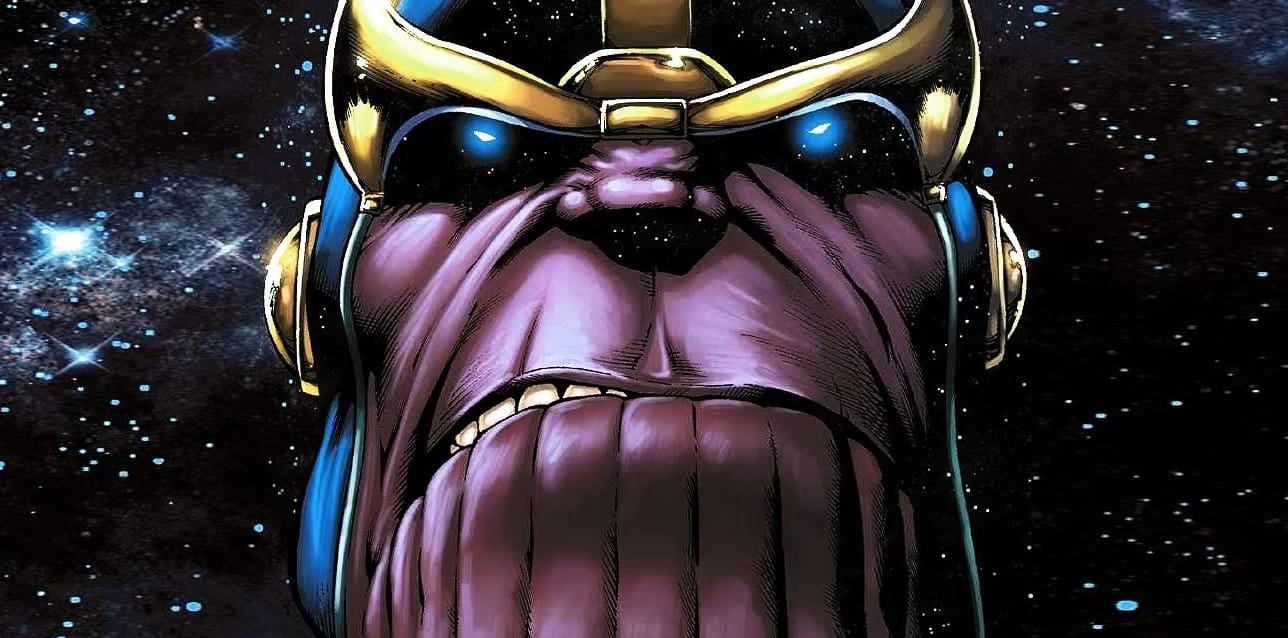
Which finally brings us, of course, to The Infinity Gauntlet.
In the comic, once Thanos puts on the Infinity Gauntlet, he is granted godlike powers, and in that moment, he not only sees all of creation, he understands it, he feels it’s pain and joy and everything in between, allowing him to empathize with it all, and this insight basically neuters his nihilistic villainy, which then leads to his downfall. In the end, after all the hubbub, Thanos retires on a secluded planet to live the rest of his life as a simple farmer. Again, this didn’t last, and Thanos still plagues the Marvel Universe to this day, but for a time… it was a satisfying ending.
And now here we are… the film in question. Finally.
I apologize for all the rambling.
Avengers: Endgame
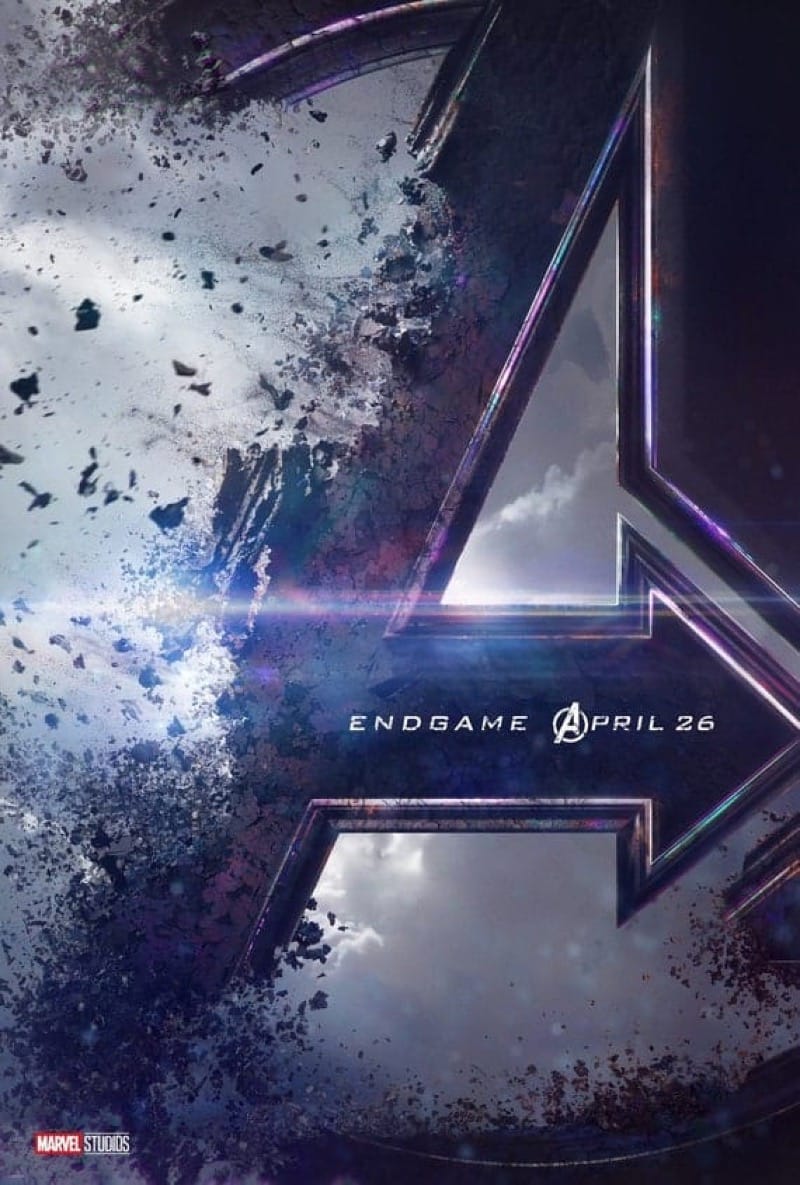
Broken and defeated at the end of Infinity War, Endgame begins somberly, as the remaining Avengers discover that Thanos has destroyed all of the Stones, making the death of half the universe a set event, one with no hope of ever undoing all that the Mad Titan has wrought. It is an opening that clearly illustrates how hollow revenge truly is, how it will never undo harm, and only ever cause more. And as the screen fades to black, we jump five years ahead to a world still reeling from having half the population having vanished in an instant, and in that desolation, those who still live, try to learn how to go on.
(Galadriel voice): “But then… something happened that Thanos had not expected… the return of the most unlikely creature imaginable… an ant… man.“
Ant-Man returned.
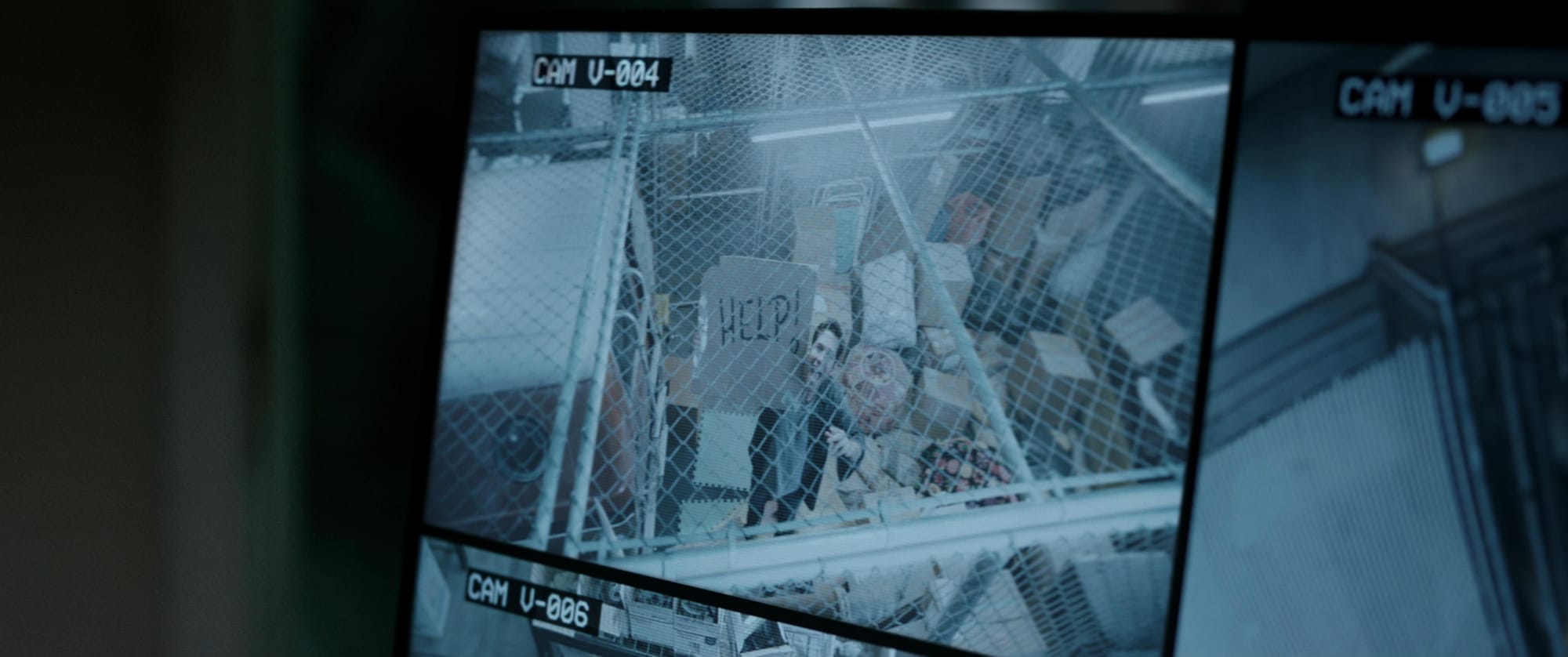
Y’see, in the sequel to the film Ant-man, Ant-man & the Wasp, at the end of the film, Soctt Lang, the second Ant-man, was exploring the micro-universe called the Quantum Realm, by way of an energy portal that he and his friends had built in the back of a Chevy van, and that’s all right with me.
At that exact moment, Thanos snaps his fingers, and all of the people who were supposed to pull Scott out of the Quantum Realm—the original Ant-Man, Hank Pym, the original Wasp, Janet Van Dyne, and the second Wasp, Hope Van Dyne—all vanish in The Blip, which strands Scott in the Quantum Realm. He was trapped there for five years, even though it only seemed like five hours to him, until a rat runs across the portal’s instrument panel in the van, accidentally turning it on, and Scott suddenly finds himself dumped out into a dank storage facility.
Because of this, the Avengers figure out how to use the Quantum Realm to travel through time (easy-peesey). Then, they come up with the basic same plan that the Justice League and the Justice Society used to save The Seven Soldiers of Victory. They’re going to split up, and then travel back in time to steal the various Infinity Stones from the various moments in time when they crossed paths with them, so that they can then bring them all back to the present and use them to bring everything back.
Sounds easy enough. No problem, right?
But when a past version of Thanos follows them back to the present, things almost go off the rails, but it all works out in the end.
This means that Ant-man basically saves everything.
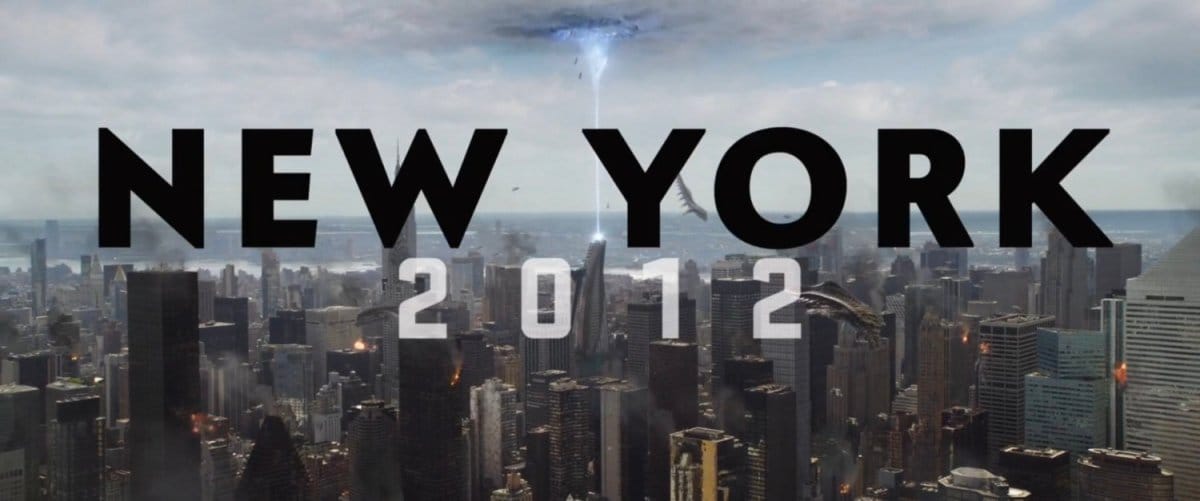
The first stop is New York City in the year 2012, the setting of the first Avengers movie.
This is the battle of New York, where the Avengers first formed in response to Loki leading a Thanos-supplied army of Chitauri warriors in the first alien invasion of Earth. Captain America, Iron Man, Hulk, and Ant-man are here to get the Mind Stone from Loki’s staff, as well as the Space Stone, which is inside of the Tesseract, both of which are in the middle of the fight at what would become Avengers Tower. They are also there for the Time Stone, and since they are a few years too early for Dr. Strange, they find The Ancient One, the Sorcerer Supreme before Dr. Strange, residing in the brownstone at 177A Bleecker Street, otherwise known as the Sanctum Sanctorum of the Sorcerer Supreme.
After a some shenanigans and a bit of bruh-haha, they get the Mind Stone and the Time Stone, but… they accidentally let Loki escape with the Tesseract.
Oops.
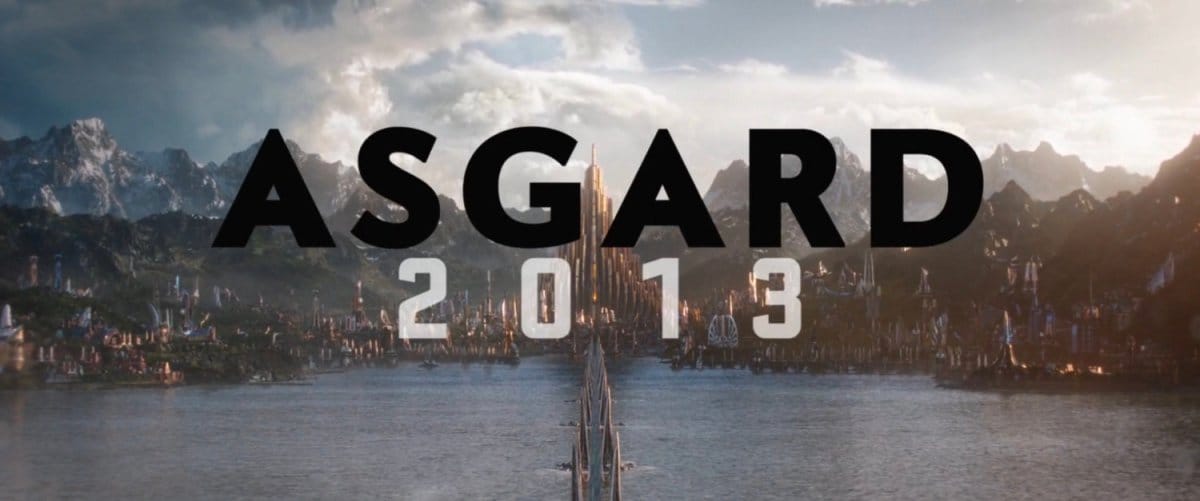
Meanwhile, Rocket Raccoon and Thor journey back to Asgard, to the year 2013, in the midst of the chaotic events that followed the return to the Nine Realms of the evil ruler of the Dark Elves of Svartalfheim, Malekith the Accursed, in the film Thor: The Dark World.
Things are off to a bit of a rough start here, as Thor’s PTSD has got the Thunder God on the back foot. So, while Rocket Raccoon is busy trying to get the Reality Stone—know in this time as the Aether—which is coursing through Jane Foster, Thor’s ex-girlfriend, and slowly killing her, Thor gets some love and reassurance, not to mention a much-needed hug too, from his Mother, Frigga, the goddess of marriage, and the wife of Odin, who is fated to be killed on that very day.
Thor and Rocket manage to get the Reality Stone. In the process, Thor discovers that, despite how he may feel at the moment, he’s still worthy, as his enchanted hammer, Mjolnir, once again answers his call and flies to his hand.
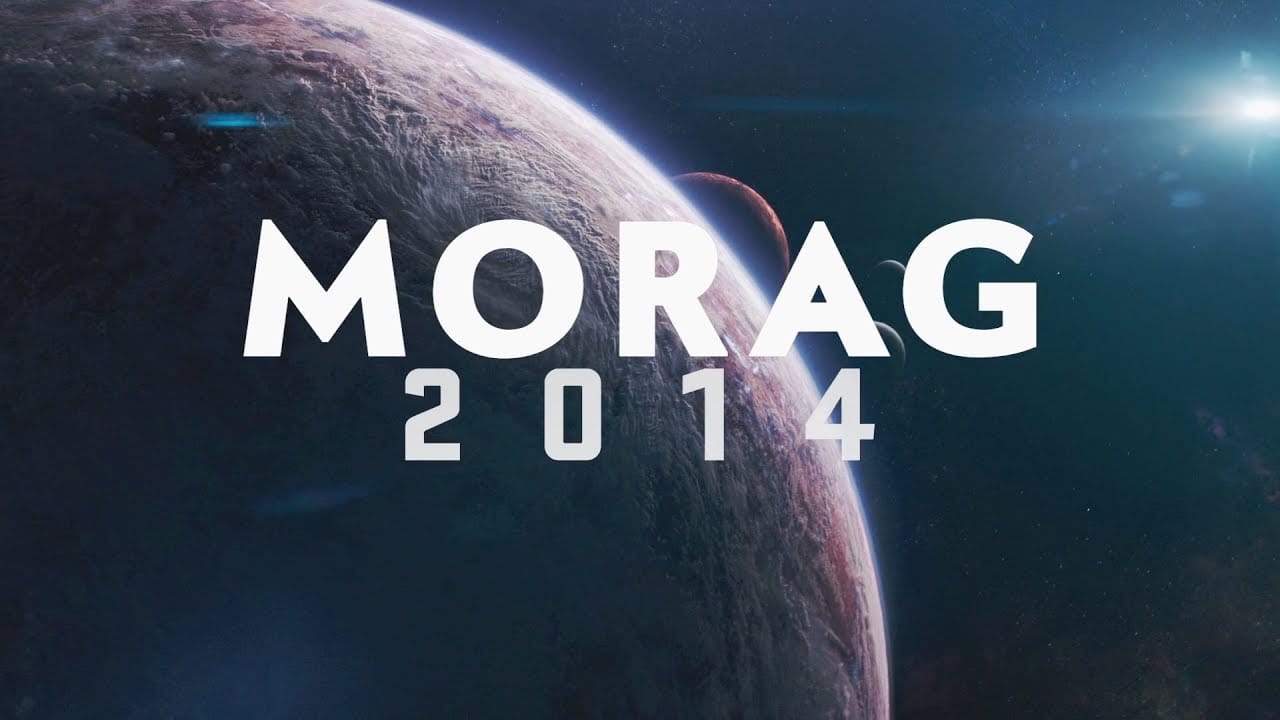
Finally, the Black Widow, Hawkeye, Nebula, and War Machine all journey to the planet Morag in the year 2014, the place where we first met Peter Quill in the first Guardians of the Galaxy movie.
Nebula and War Machine hope to get the Power Stone, known at the time as The Orb, before Peter Quill does. And while Nebula and War Machine do that, Black Widow and Hawkeye fly off to the planet Vormir, where the specter of the Red Skull guards the Soul Stone.
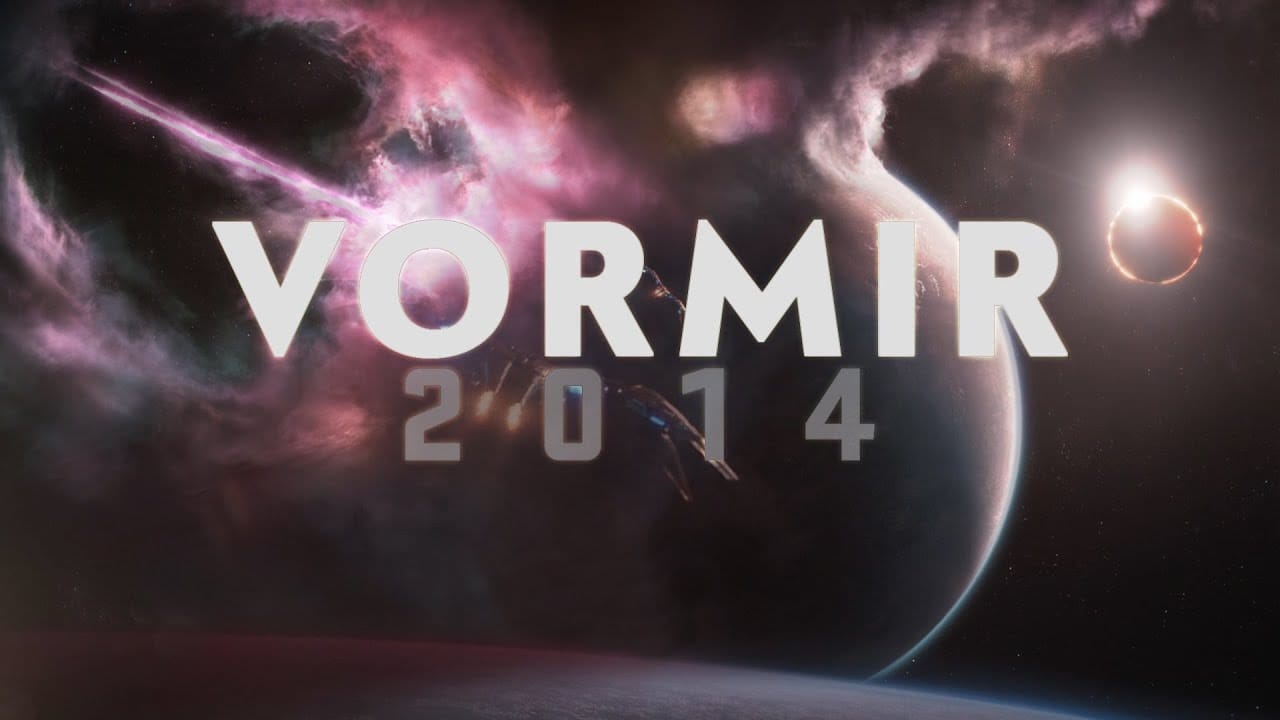
There’s just two problems with this mission…
One, the 2023 version of Nebula still uses the same neural network that the 2014 Nebula used, and this bit of whoopsey-daisy leads to Nebula in 2014, who was still evil and still desperate for Thanos’s approval, to not only reveal the Avengers‘ plan to Thanos, but also the fact that the victorious Thanos of the future was killed by the surviving members of the Avengers.
On top of that, on the planet Vormir, Hawkeye and Black Widow are old friends who go way back, and care about each other very much, and if they want the Soul Stone—which they do—then one of them is going to have to die. The Black Widow makes the decision for them both, and sacrifices herself.
Hawkeye returns with the Soul Stone, and War Machine returns with the Power Stone, unknowingly accompanied by the evil Nebula of 2014…

Meanwhile, low on Pym Particles, the necessary component for Time Travel, and only able to make one more time jump, and having lost the Space Stone when the 2012 version of Loki manage to escape with the Tesseract (see the tv show Loki for more information), Ant-man returns to the Present with the Mind Stone and Time Stone, while Captain America and Iron Man jump farther back into the past.
Using their last dose of Pym Particles to travel back to Camp Lehigh, New Jersey, in the year 1970. Camp Lehigh is both the birthplace of Captain America in WW2, as well as the birthplace of SHIELD after the war. There was no movie or show that was set here specifically, but it’s been established in more than a few of them as an important time and place.
Here, Cap and Iron Man plan on grabbing more Pym Particles, so they can get home. They know they can do this because a young Hank Pym, the original Ant-Man, worked at Camp Lehigh at the time. They also plan on grabbing the Power Stone, as the Tesseract is being stored there too, after it had been recovered from the Atlantic Ocean following the events of the first Captain America movie.
But, while Tony grabs the Tesseract from deep storage, he runs into his long-dead Father, a man who, at the time, was about to become a new father himself. Tony, now a father himself, gets a little closure with his father while talking about the fears and responsibilities that come with being a first time parent.
Meanwhile, while Captain America is grabbing more Pym Particles, he catches a brief glimpse of his time-lost true love, the current Director of SHIELD, Peggy Carter, and is once again reminded of all that he has lost.
The pair return to the Present with the Space Stone.
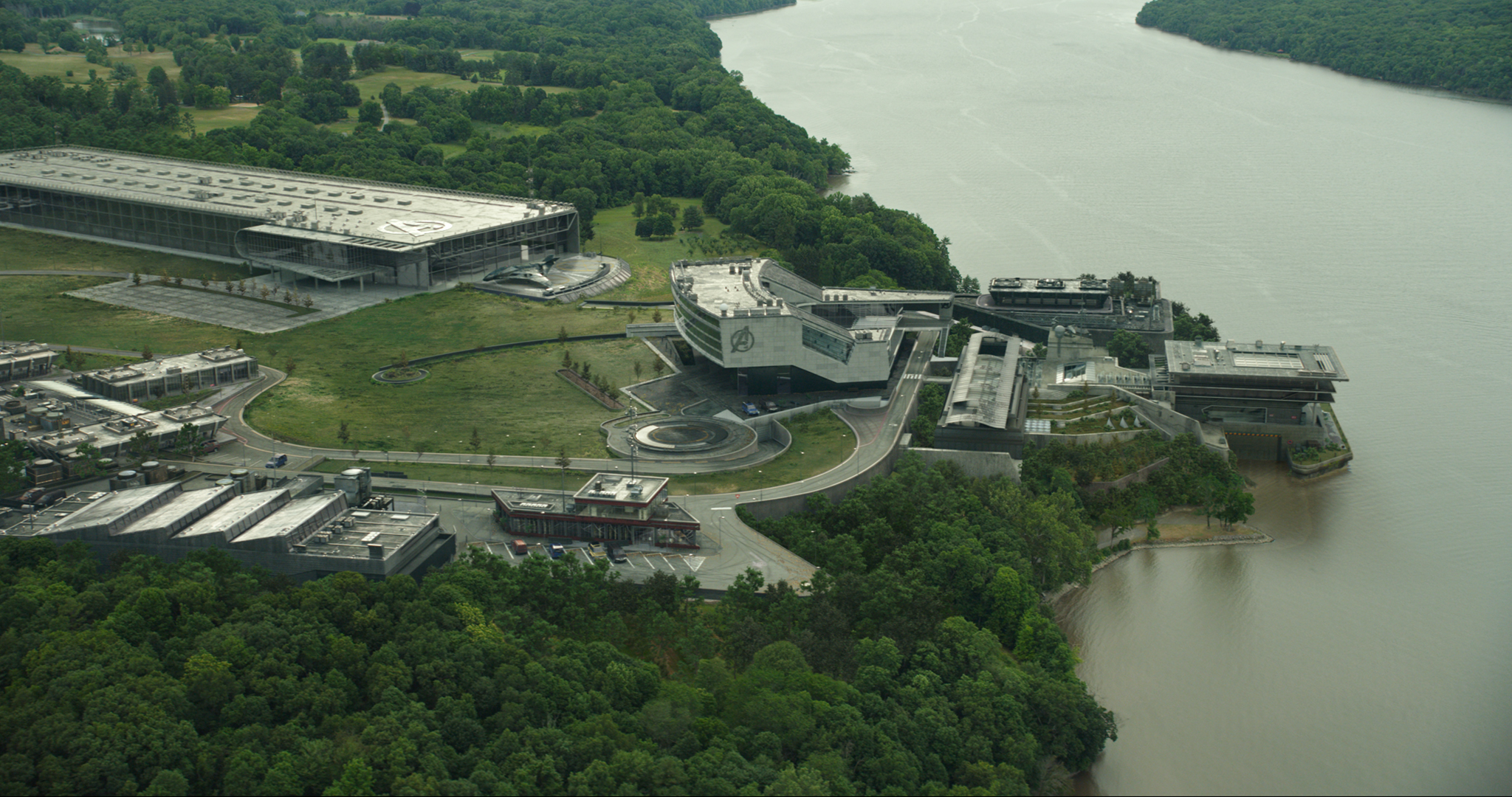
Because this is time travel, the Avengers all return at the same moment, to the exact moment that they left the Avengers’ compound in the year 2023, minus the Black Widow, of course, and with a snake in their midst, as the evil Nebula from 2014 stands amongst them. The Avengers then build a new gauntlet, and The Hulk is barely powerful enough to withstand the backlash of power that comes with using the Stones. This returns everyone that was lost in the Blip.
But then, just a few seconds later, the bad Nebula from 2014 powers up the portal and brings Thanos and his massive warship forward in time—along with the 2014 version of Gamorra and the good Nebula from 2023—and Thanos blows the shit out of Avengers compound, burying most of the Avengers in the rubble.
After that, shit gets real.
It’s basically like Middle School recess when the familiar call goes out…
“Fight! Fight! Fight!”
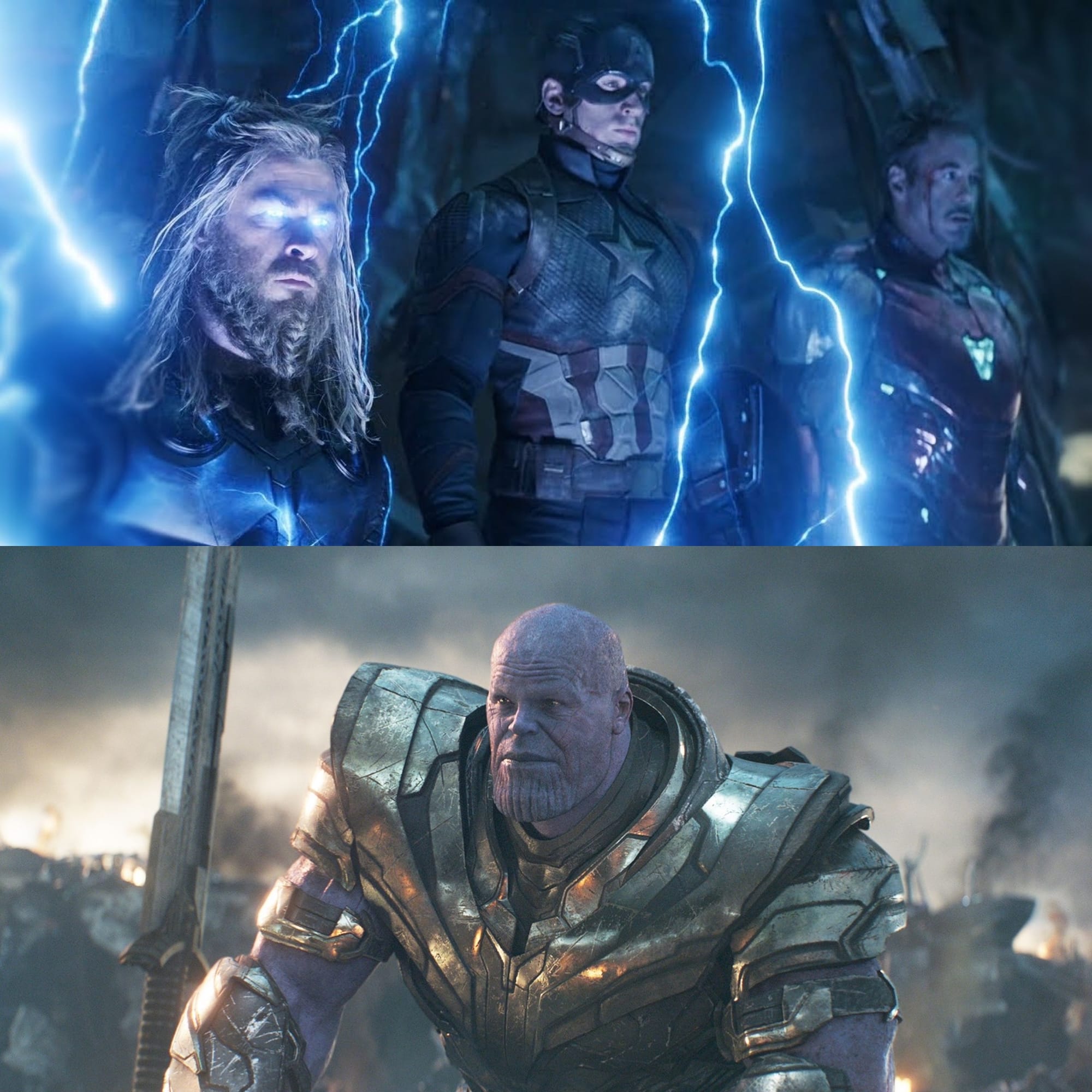
At first, it’s just Captain America, Thor, and Iron Man vs Thanos. The Big Three against the Big Purple. It’s a great fight, full of iconic moments. We get a big pay-off of a moment that was seeded around five years earlier in Age of Ultron, where we see that Thor is not the only one who is worthy enough to lift Mjolnir. We also get a perfect call-back to Cap’s unofficial underdog mantra: “I can do this all day.”
Then, in the wreckage of the Avenger’s compound, all of the heroes who vanished in the Blip shows up, and suddenly it’s the Battle of the Six Armies in upstate New York, as Wakanda, Asgard, Kamar-taj, and the Ravagers all join with the Avengers against Thanos, the Black Order, and the gathered might of his horde.
It’s four-color fisticuffs galore!
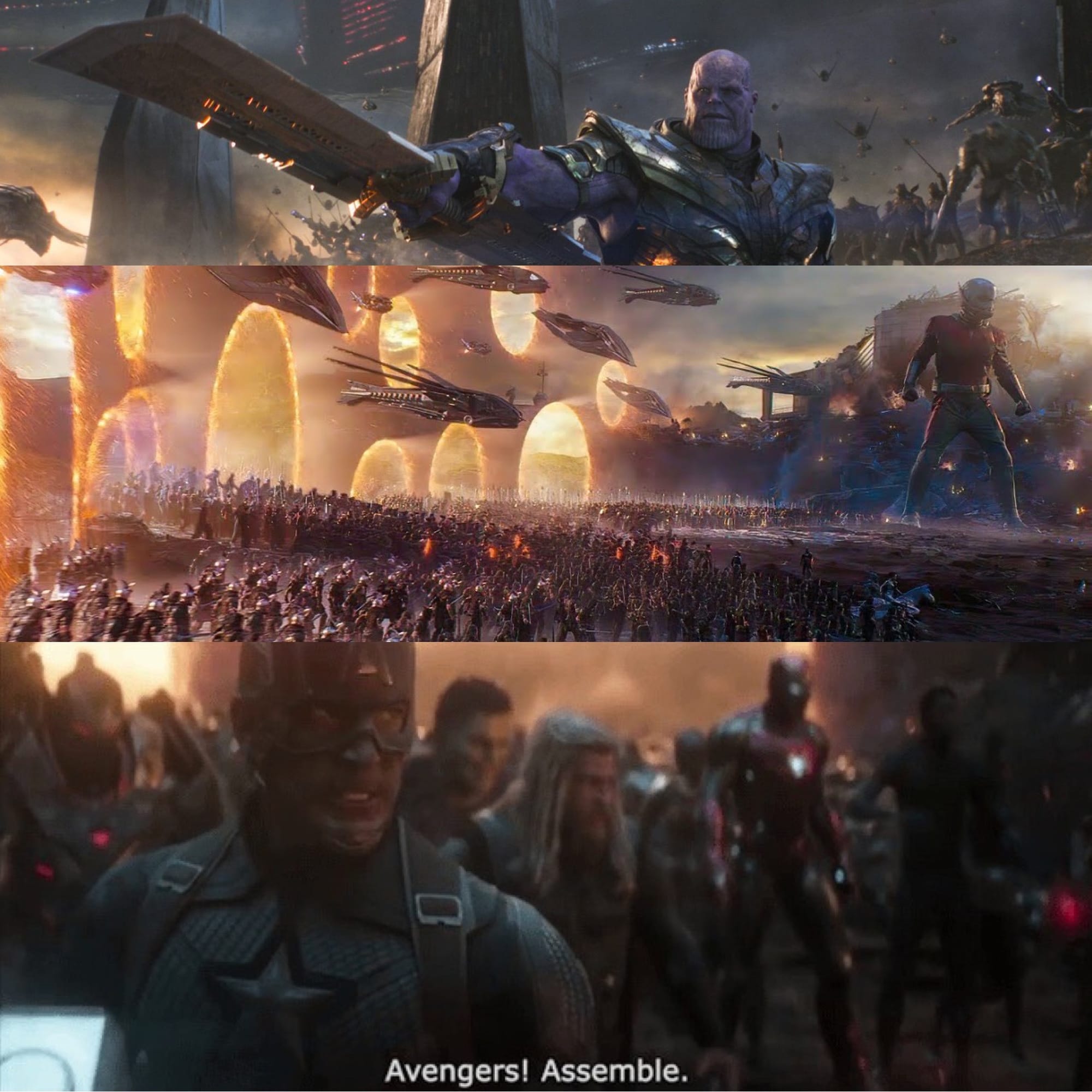
This is a completely satisfying movie, and it peaks so hard with this last fight. It’s just perfect. I loved it.
Now, some of you might wonder why ”Avengers! Assemble!” is the Avengers’ classic battle cry. And the answer, as is often the case when it comes to reasons why things are what they are in comic books, is… alliteration, my friends. That’s it. Alliteration. Alliteration is cornerstone of all comic book superhero universes.
Not only is Endgame a fantastic time travel romp, but it’s a romp through the history of the MCU too, celebrating the very storyline we are here to see the climax of. It is the perfect second half to an already fantastic adaptation of a classic comic book crossover, all while also being a perfect summer blockbuster. It’s just a good time. As much as Infinity War ended with such a gut punch of a cliffhanger, this film delivers all the satisfying resolution that you could want.
I loved it. Every moment of it.
I could also nerd out a bit, and point out that Black Panther knows Hawkeye’s name now because of a quick interaction during their fight in the movie Civil War. Or the quick look that passes between Ant-man and the Wasp after she calls Captian America “Cap” because of how Scott bragged in Ant-Man 2 of how that is what Cap’s friends call him. Or how we finally got to see the Instant Kill setting in Spider-man’s armored spider-suit, which was first mentioned in the first Spider-man movie, Spider-man: Homecoming, and how it is really not an appropriate setting option for Spider-man. Or how the film clearly shows that Scarlet Witch and Captain Marvel are the strongest Avengers, which makes sense, as their powers are both linked to the Infinity Stones. Or how, when Happy Hogan asks Morgan what he can get her to maybe help her feel better, as they’re sitting on the porch at her father’s wake, and how, when she says that she wants a cheeseburger, it’s a callback to the very first Iron Man movie, just like Tony’s final kill-pun is to Thanos: “I am Iron Man,” as it was the phrase that finished the first movie, and launched the MCU.
Little things, yes, but immensely satisfying.
Also, in the beginning of the film, Ken Jeong, playing a security guard at the storage place that Ant-Man reappears in, is seen reading a book by J.G. Ballard called "The Terminal Beach.” It’s a collection of Ballard’s sci-fi short stories. In the US edition, the first story in the book is titled "End-Game,” which is about a man named Constantin who has been sentenced to death for being a revolutionary, and is forced to share a house with a man named Malek, his executioner. The problem is, Malek will not reveal the time or the method of Constantin’s execution. It could happen at any moment, in any way. so, the two mostly sit and play chess, all while Constantin tries trick Malek into revealing when and how his death will come.
This means nothing as far as the film goes, but y’know… there’s a little bit of nerd trivia for your pocket.
Overall, I loved this film. It was very satisfying.
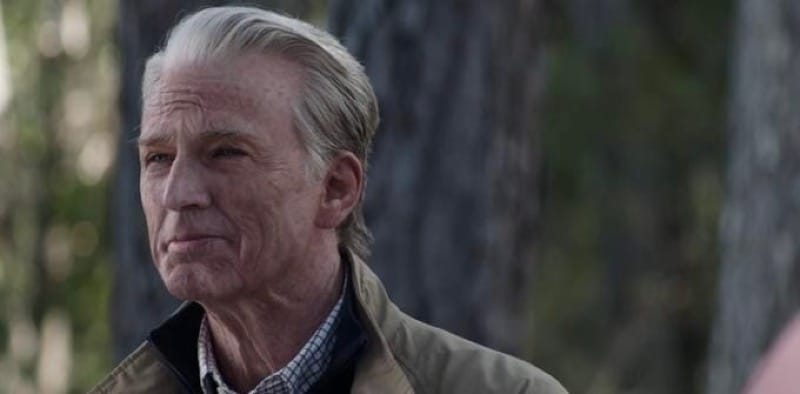
For me at least, my complaints are few, like…
While I didn’t have a problem with the whole Black Widow/Hawkeye sacrifice thing, I do think Ronin was just generally bad optics as far as racial stuff goes. It’s not a bad idea, or even all that uncommon in comics, in fact whole characters are built out of the idea of a quest for revenge after the loss of their family, it’s just that it’s presented poorly here, which is surprising to me. I mean, how did they think it’d look to have a white guy traveling the world, after deciding, in his grief, to kill all the POC “scum” criminals he can, not because they killed his family… because they didn’t… but simply because they’re still alive, while his family is not. It’s awkward, right? And kind of gross, especially when it’s plainly stated.
Also, I think there should‘ve been a short montage of Tony Stark noodling at the problem of Time Travel a little longer. It’s not like it’s really ever in doubt whether or not the problem would be solved, and it is a 3 hour plus movie as is, but still, it would’ve been better to see him take at least a couple of days of trying and failing to figure out the math needed to time travel successfully, instead of it being more like him throwing a wad of paper over his shoulder and somehow hitting the basket on the first time.
But y’know… it was gonna happen regardless, so whatever.
Also… while I really liked Fat Thor and his PTSD, there were a couple of fat jokes involved with that whole thing that were kind of shitty.
Finally, and this is a small thing, most likely for time concerns, they very obviously cut out a conversation between Tony and his 4 year old daughter Morgan that went something like her saying: ”I love you a bunch” and Tony then responding “Well, I love you a ton,” and so she asks what a ton is, and he says that it’s two thousand pounds, which is why she then says “I love you 3000.” It all ends up in the same place in the final cut, but it would’ve seemed much less random if that exchange had been left in.
Other than that, the funniest complaint I heard about this film came from the usual gaggle of terminally online head-up-their-ass dipshits. These asshats were so fucking mad, just frothing at the mouth, that the film very briefly implied through an anecdotal throw-away line—where Cap mentions seeing whales in the Hudson—that having half the population wiped out was actually good for the planet. They called it pro-genocide. I sometimes wonder if those stupid assholes still mad about that too. I’d bet anything they are. In fact, I‘d be willing to bet it’s still their whole personality. But on top of that, I can’t help but wonder if they’re still mad about it after seeing how pollution levels dropped when everyone was staying home during the early days of COVID? They’re probably too dumb to make the connections…
The main complaint that I heard a lot of after this film first came out was a very sneering and dismissive “it’s full of fanservice!“ Fanservice is material in a work of fiction that is intentionally included in order to please the audience. I don’t know if it originated with Anime, but that seems to be where it’s most common, and that’s why fanservice is generally thought of being, like… the main characters all pause the story for a chapter and go to the beach in tiny swimsuits, or they all go to the public bath together, so there’s lots of nudity, but that’s not what it always is. The root of the idea is that it’s about giving your main fans exactly what they want, so it can also be pay-offs and wrap-ups and nods to old stories, or finally delivering on long expected moments, etc…
Which means that this complaint is not wrong. The MCU is nothing if not self-referential. Endgame especially is mostly fanservice. It’s the big pay-off to a decade long, multiple franchise storyline, how can it be expected to be anything other than fanservice? This film is a big celebration of itself. So, while the complaint isn’t wrong, I can only say…
I guess so, but why is that bad?
Honestly, I thought they did a pretty good job of balancing it all. Not perfect, of course, but pretty good.

And so, we are left with the last big question…
What exactly happened to Captain America at the end?
At the end of the film, Captain America is the one who is tasked with returning all of the Infinity Stones to the exact moment in the past that the Avengers gathered them from, and thus, insuring that the past still happens in the right way.
For him, the trip to the past was supposed to take as long as he needed, but for the present, it was only supposed to take a moment. But when Cap returned, he was an old man, one who was ready to pass on his famous shield, as well as the mantle of Captain America, to Sam Wilson, The Falcon. Also, he was wearing a wedding ring, and while he didn’t offer any explanation for what happened, he seemed to be pretty content with whatever his experiences had been.
So, what exactly did he experience?
There are only a couple of options here. He either went back, returned everything to its rightful place, and then went and found Peggy and lived with her and ignored the world, presumably just letting the past unfold like it always did, and then, once things really started to kick into high gear in the MCU, probably right around the time when he was found in the ice at the end of the first Captain America movie, Cap then returned to the Present. People joked that this would mean ignoring not just the fact that Hydra had infiltrated SHIELD, but all of people who were going to die over the years as a results of all the trouble the heroes were going to face, but yeah… it’s not like he had much of a choice, not if he wanted the future to work out in the end. He probably told Peggy what happened, and the two of them just lived a life for themselves, something they deserved.
This is the most likely answer.
But…
If it makes you feel better, it’s okay to imagine that he and Peggy lived a full life together, one where they used their future knowledge to clean up SHIELD, and to create the Avengers early, and as a result, were able to deal with Thanos before he became a problem, all of which basically insures them a better world, an Avengers World, a world that would eventually become a sprawling human empire bringing hope and light across the known galaxy, an endeavor that—much like Gandalf with the One Ring—would be started with the best of intentions, but would eventually become an evil oppressive force darkening the skies of rebel worlds scattered amongst the distant stars.
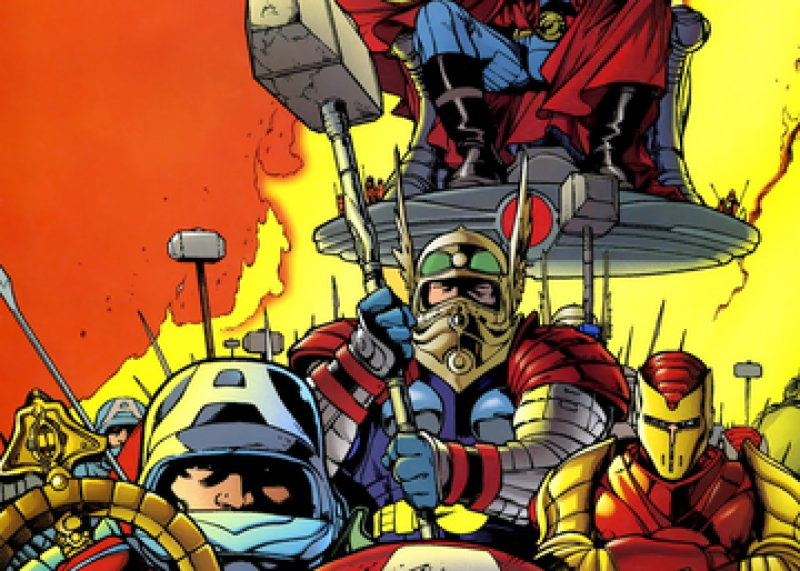
But that possible future probably wasn't set, when Peggy finally passed, and Cap, knowing that this alternate world was now safe in the hands of worthy protectors—probably his and Peggy’s children—decided to finally return to the moment he had originally left.
Of course, there’s a couple of problems with this alternate world idea, like… what happened to the Captrain America that was still frozen in the ice? Did Cap and Peggy just leave him there? I assume not, as that seems cruel, and also when Cap comes back, he’s got a new and undamaged shield. That is most likely the shield that the cap who was still frozen in the ice had on him, right? So… did Cap kill his past self and take his shield?
Really, the question of where Cap got the replacement shield is more than a bit problematic, at least in a narrative sense. But more importantly, if you’re going to adhere to this latter alternate reality theory, what happened when Cap finally does return to the present, doesn’t this then wipe out that alternate timeline completely, basically killing all of its inhabitants? That seemed to be what was implied by the Hulk when he explained to the Ancient One how they were planning on returning the Time Stone…
In the end, I guess the real answer to the question of what exactly happened to Captain America while he was in the past is simply…
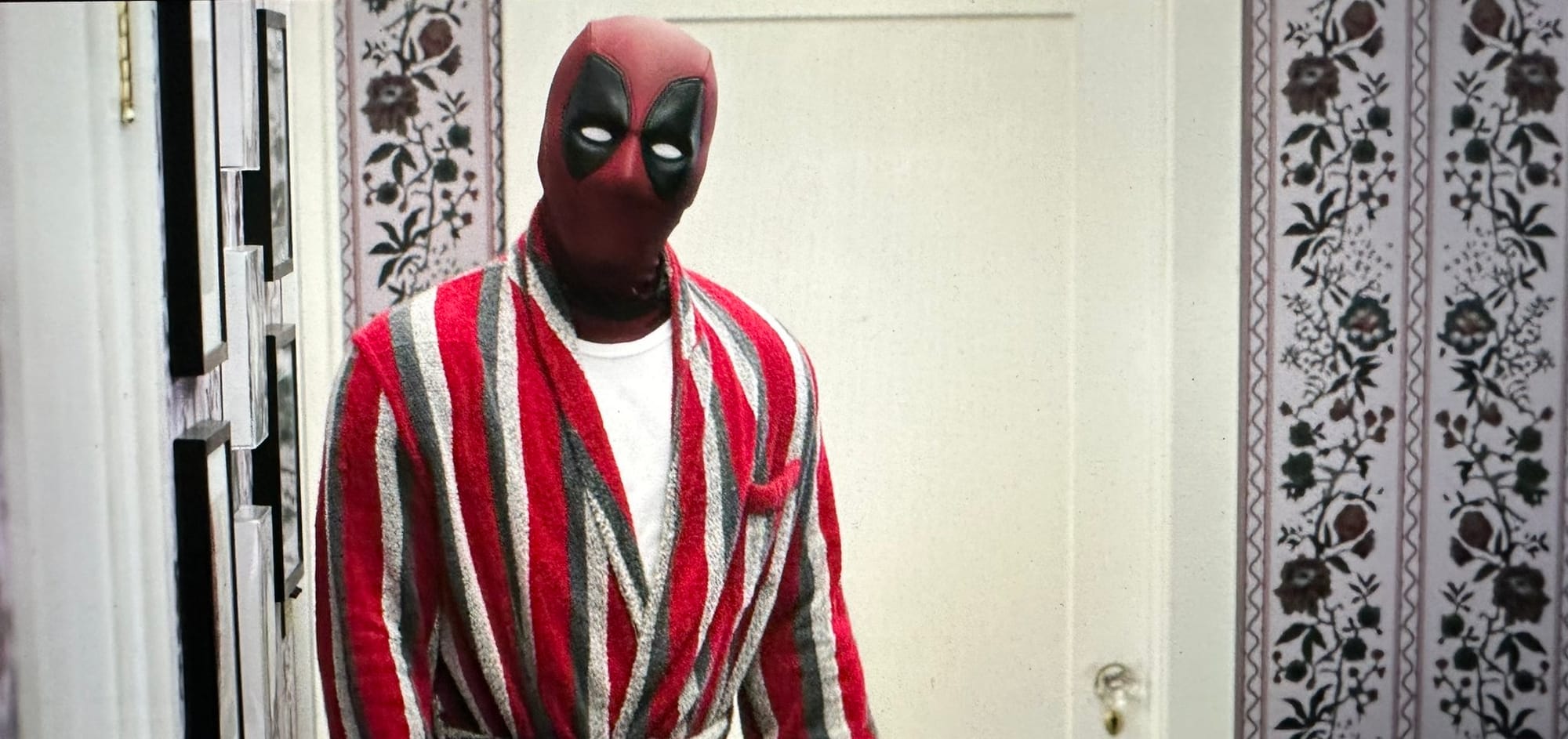
Shut up. The movie’s over. Go home.
